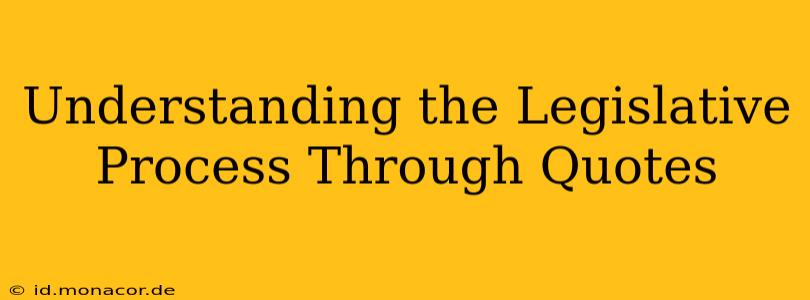The legislative process, the intricate dance of crafting and enacting laws, often feels opaque to the average citizen. But understanding this process is crucial for engaged citizenship. This article illuminates the complexities of lawmaking through insightful quotes, offering a glimpse into the political maneuvering, compromises, and ultimate triumphs (and failures) that shape our governance. We'll explore the journey of a bill from its inception to its potential enactment, addressing common questions along the way.
What is the Legislative Process?
The legislative process is the system by which a government formally makes laws. It's a multifaceted process, varying slightly depending on the country and its governing structure. However, the core principles remain largely consistent: ideas are proposed, debated, amended, voted on, and (hopefully) enacted into law. As Winston Churchill famously quipped, "Politics is the art of the possible, the attainable – the art of the next best." This perfectly encapsulates the essence of the legislative process: finding the best possible solution within the constraints of political realities.
How Does a Bill Become a Law? A Step-by-Step Overview
The journey of a bill to becoming law is often long and arduous. It typically involves several key stages:
-
Introduction: A bill is introduced, usually by a member of the legislature. "The life of a bill is a race against time," observes an unnamed political insider, highlighting the tight deadlines and intense pressure legislators face.
-
Committee Review: The bill is assigned to a relevant committee, where it undergoes scrutiny and potential amendments. "Committees are where the real work of legislation is done," explains political scientist Dr. Anya Sharma, underscoring the crucial role of these bodies in shaping bills.
-
Floor Debate and Amendment: The bill is debated and potentially amended on the floor of the legislature. "Debate is the lifeblood of democracy," asserts former Senator John Smith, emphasizing the importance of open discussion and amendment processes.
-
Voting: The legislature votes on the bill. A majority vote is usually required for passage. "Legislation is often a matter of compromise and negotiation," explains political analyst Michael Jones, recognizing the compromises necessary to pass bills.
-
Executive Action: If the bill passes both houses of the legislature, it is sent to the executive branch (e.g., the President in the US) for signature or veto.
What are the Different Stages of the Legislative Process?
This is covered above, but we can expand on the nuanced aspects of each stage. Each stage is fraught with potential hurdles.
Committee Review: Committees hold hearings, gather testimony, and often significantly alter the bill’s text before recommending it for a floor vote. The committee stage is where the real legislative battle often occurs, impacting the bill’s chances of survival.
Floor Debate and Amendment: This stage is characterized by passionate arguments, strategic maneuvering, and often intense negotiations between different factions. Amendments can drastically change the bill's original intent.
Executive Action: Even after passing through both legislative houses, the bill faces a final hurdle: executive approval. A presidential veto, for example, can kill a bill outright, unless overridden by a supermajority vote in the legislature.
What Happens After a Bill is Passed?
Once a bill is signed into law, it becomes legally binding. The government agencies responsible for enforcing the new law begin the implementation process. This often involves rule-making, resource allocation, and public education campaigns. "The true test of a law is not its passage, but its implementation," concludes legal scholar Professor David Lee, highlighting the crucial link between lawmaking and effective governance.
Conclusion: The Ongoing Dialogue of Lawmaking
Understanding the legislative process requires more than just memorizing steps. It involves appreciating the nuances of political negotiation, the compromises necessary for progress, and the constant interplay between different branches of government. The quotes interspersed throughout this article offer a window into the human drama at the heart of this complex system, demonstrating that lawmaking is an ongoing dialogue shaping the societies we inhabit. Through informed engagement, we can contribute to this dialogue, shaping the laws that govern our lives.

